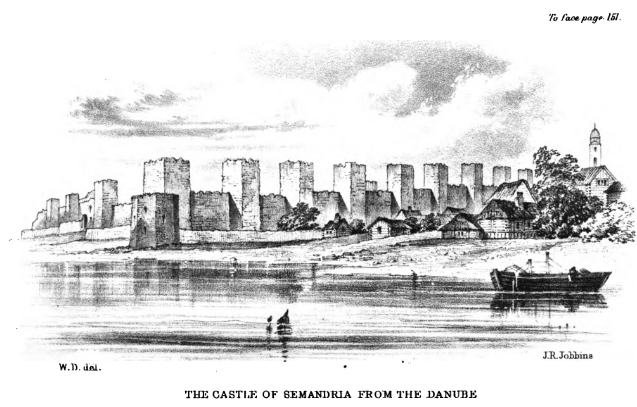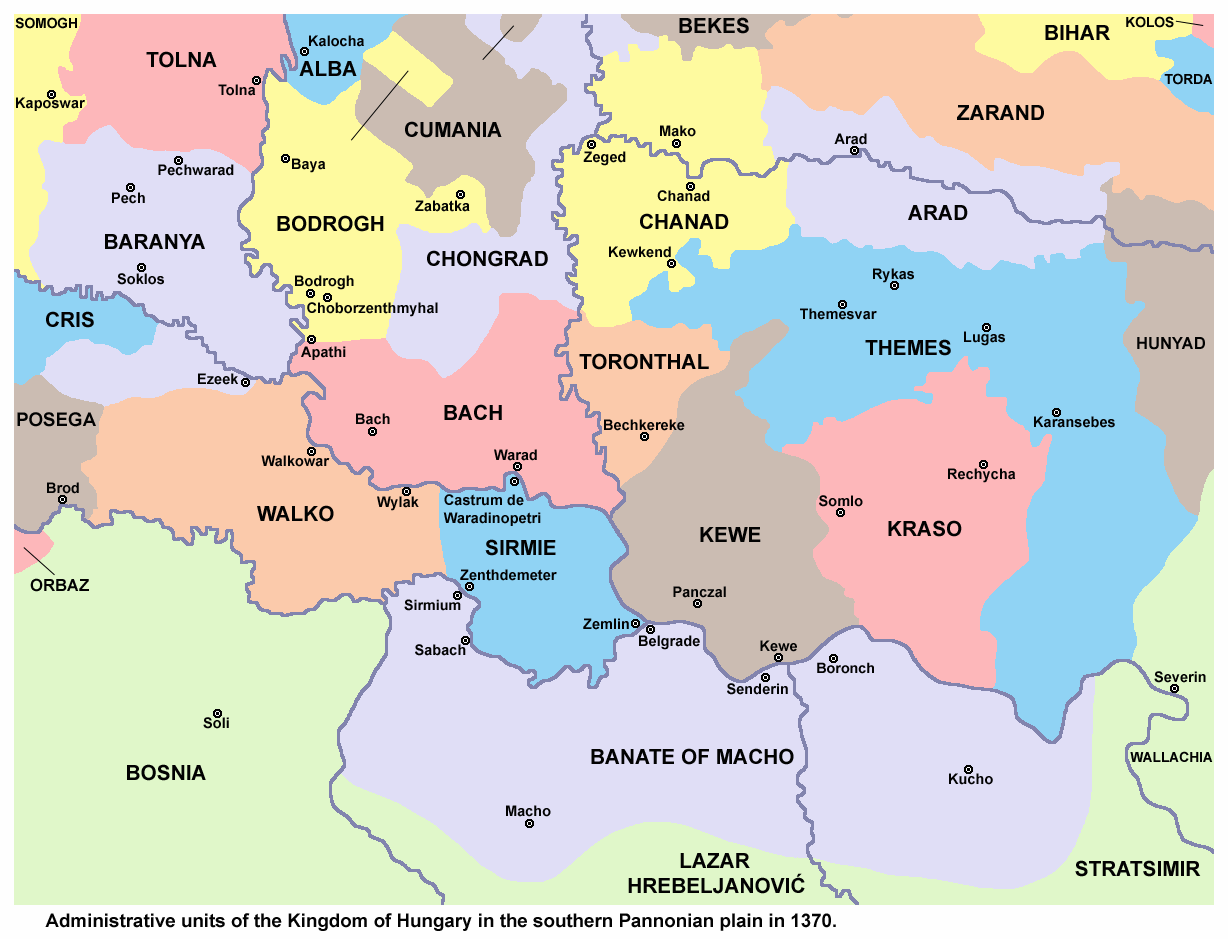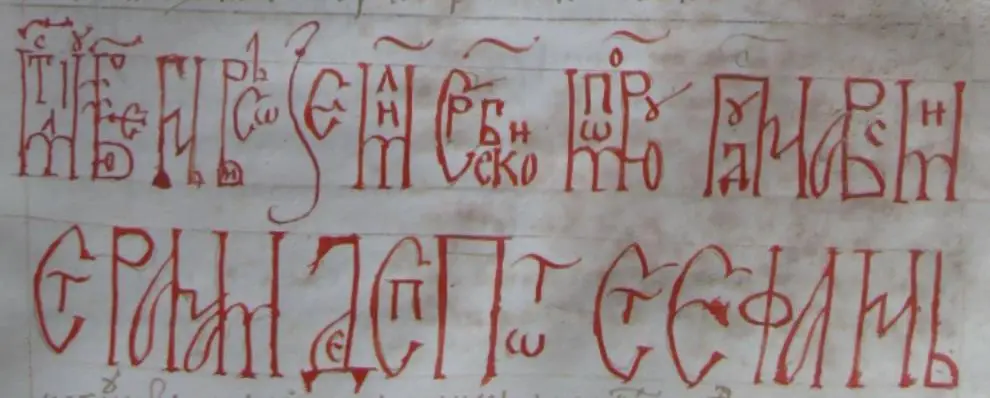SERVIA,
YOUNGEST MEMBER OF THE EUROPEAN FAMILY:
OR, A
RESIDENCE IN BELGRADE,
AND
TRAVELS IN THE HIGHLANDS AND WOODLANDS OF THE INTERIOR,
DURING THE YEARS 1843 AND 1844.
BY
ANDREW ARCHIBALD PATON, ESQ.
CHAPTER V.
Description of Belgrade.—Fortifications.—Streets and Street Population.—Cathedral.—Large Square.—Coffe-house.—Deserted Villa.—Baths.
Through the courtesy and attention of Mr. Consul-general Fonblanque and the numerous friends of M. Petronievitch, [1] I was, in the course of a few days, as familiar with all the principal objects and individuals in Belgrade, as if I had resided months in the city.
The fare of a boat from Semlin to Belgrade by Austrian rowers is five zwanzigers, or about 3s. 6d. English; and the time occupied is half an hour, that is to say, twenty minutes for the descent of the Danube, and about ten minutes for the ascent of the Save. On arrival at the low point of land at the confluence, we perceived the distinct line of the two rivers, the Danube faithfully retaining its brown, muddy character, while the Save is much clearer. We now had a much closer view of the fortress opposite. Large embrasures, slightly elevated above the water’s edge, were intended for guns of great calibre; but above, a gallimaufry of grass-grown and moss-covered fortifications were crowned by ricketty, red-tiled houses, and looking very unlike the magnificent towers in the last scene of the Siege of Belgrade, at Drury Lane. Just within the banks of the Save were some of the large boats which trade on the river; the new ones as curiously carved, painted, and even gilded, as some of those one sees at Dort and Rotterdam. They have no deck—for a ridge of rafters covers the goods, and the boatmen move about on ledges at the gunwale.
The fortress of Belgrade, jutting out exactly at the point of confluence of the rivers, has the town behind it. The Servian, or principal quarter, slopes down to the Save; the Turkish quarter to the Danube. I might compare Belgrade to a sea-turtle, the head of which is represented by the fortress, the back of the neck by the esplanade or Kalai Meidan, the right flank by the Turkish quarter, the left by the Servian, and the ridge of the back by the street running from the esplanade to the gate of Constantinople.
We landed at the left side of our imaginary turtle, or at the quay of the Servian quarter, which runs along the Save. The sloping bank was paved with stones; and above was a large edifice with an arcade, one end of which served as the custom-house, the other as the Austrian consulate.
The population was diversified. Shabby old Turks were selling fruit; and boatmen, both Moslem and Christian—the former with turbans, the latter with short fez’s—were waiting for a fare. To the left was a Turkish guard-house, at a gate leading to the esplanade, with as smart a row of burnished muskets as one could expect. All within this gate is under the jurisdiction of the Turkish Pasha of the fortress; all without the gate in question, is under the government of the Servian Prefect of Belgrade.
We now turned into a curious old street, built quite in the Turkish fashion, and composed of rafters knocked carelessly together, and looking as if the first strong gust of wind would send them smack over the water into Hungary without the formality of a quarantine; but many of the shops were smartly garnished with clothes, haberdashery, and trinkets, mostly from Bohemia and Moravia; and in some I saw large blocks of rock-salt.
Notwithstanding the rigmarole construction of the quarter on the water’s edge, (save and except at the custom-house,) it is the most busy quarter in the town: here are the places of business of the principal merchants in the place. This class is generally of the Tsinsar nation, as the descendants of the Roman colonists in Macedonia are called; their language is a corrupt Latin, and resembles the Wallachian dialect very closely.
We now ascended by a steep street to the upper town. The most prominent object in the first open space we came to is the cathedral, a new and large but tasteless structure, with a profusely gilt bell-tower, in the Russian manner; and the walls of the interior are covered with large paintings of no merit. But one must not be too critical: a kindling of intellectual energy ever seems, in most countries, to precede excellence in the imitative arts, which latter, too often survives the ruins of those ruder and nobler qualities which assure the vigorous existence of states or provinces.
In the centre of the town is an open square, which forms a sort of line of demarcation between the crescent and the cross. On the one side, several large and good houses have been constructed by the wealthiest senators, in the German manner, with flaring new white walls and bright green shutter-blinds. On the other side is a mosque, and dead old garden walls, with walnut trees and Levantine roofs peeping up behind them. Look on this picture, and you have the type of all domestic architecture lying between you and the snow-fenced huts of Lapland; cast your eyes over the way, and imagination wings lightly to the sweet south with its myrtles, citrons, marbled steeps and fragrance-bearing gales.
Beside the mosque is the new Turkish coffee-house, which is kept by an Arab by nation and a Moslem by religion, but born at Lucknow. One day, in asking for the mullah of the mosque, who had gone to Bosnia, I entered into conversation with him; but on learning that I was an Englishman he fought shy, being, like most Indian Moslems when travelling in Turkey, ashamed of their sovereign being a protected ally of a Frank government.
I now entered the region of gardens and villas, which, previous to the revolution of Kara Georg, [2] was occupied principally by Turks. Passing down a shady lane my attention was arrested by a rotten moss-grown garden door, at the sight of which memory leaped backwards for four or five years. Here I had spent a happy forenoon with Colonel H——, and the physician of the former Pasha, an old Hanoverian, who, as surgeon to a British regiment had gone through all the fatigues of the Peninsular war. I pushed open the door, and there, completely secluded from the bustle of the town, and the view of the stranger, grew the vegetation as luxuriant as ever, relieving with its dark green frame the clear white of the numerous domes and minarets of the Turkish quarter, and the broad-bosomed Danube which filled up the centre of the picture; but the house and stable, which had resounded with the good-humoured laugh of the master, and the neighing of the well-fed little stud (for horse-flesh was the weak side of our Esculapius), were tenantless, ruinous, and silent. The doctor had died in the interval at Widdin, in the service of Hussein Pasha. I mechanically withdrew, abstracted from external nature by the “memory of joys that were past, pleasant and mournful to the soul.”
I then took a Turkish bath; but the inferiority of those in Belgrade to similar luxuries in Constantinople, Damascus, and Cairo, was strikingly apparent on entering. The edifice and the furniture were of the commonest description. The floors of the interior of brick instead of marble, and the plaster and the cement of the walls in a most defective state. The atmosphere in the drying room was so cold from the want of proper windows and doors, that I was afraid lest I should catch a catarrh. The Oriental bath, when paved with fine grained marbles, and well appointed in the departments of linen, sherbet, and narghilé, is a great luxury; but the bath at Belgrade was altogether detestable. In the midst of the drying business a violent dispute broke out between the proprietor and an Arnaout, whom the former styled a cokoshary, or hen-eater, another term for a robber; for when lawless Arnaouts arrive in a village, after eating up half the contents of the poultry-yard, they demand a tribute in the shape of compensation for the wear and tear of their teeth while consuming the provisions they have forcibly exacted.
[1] Tran. note: Avram Petronijević, secretary to Knez Miloš Obrenović, multiple times the Serbian representative (ćehaja) with the Sublime Porte, diplomat, Minister of Foreign Affairs and longest-serving Prime Minister of Serbia in a single mandate (1844-1852), as well as a prominent member of the Ustavobranitelji (Defenders of the Constitution) group, which sought to limit the powers of the Knez. Spoke German, Greek, Romanian, Italian, Turkish and French.
[2] Tran. note: Đorđe Petrović, better known for his nickname Karađorđe (Black George). Leader of the First Serbian Uprising (1804-1813) and the founder of the Karađorđević dynasty. Karađorđe first came to prominence during the Austro-Turkish war of 1788-1791 as a member of the Serbian freikorps (Serb auxiliaries from Serbia who fought with the Austrians). After the defeat of Austria, he lived in exile in Austria until 1794 when a general amnesty was announced. Until the start of the First Serbian uprising in 1804, he was a livestock merchant and after the defeat of the First Serbian Uprising, he escaped again to Austria, which handed him over to Russia instead of extraditing him to the Ottomans. In 1817 he returned to Serbia, but was promptly killed by agents of Miloš Obrenović, out of fear that the Ottomans would go back on the freedoms that they granted Serbia after the Second Serbian Uprising (1815-1817).



